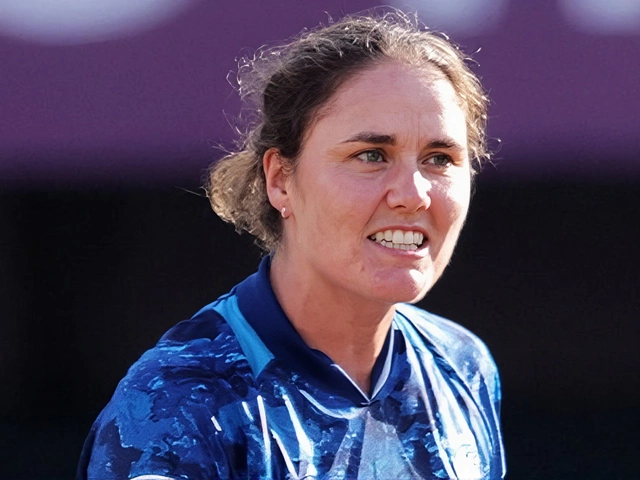England Women edge Bangladesh Women by 4 wickets in thrilling World Cup clash in Guwahati

It wasn’t pretty, but it was perfect. England Women scraped past Bangladesh Women by four wickets in a nail-biting finish at the Barsapara Cricket Stadium in Guwahati, India, on October 6, 2025 — the kind of win that separates champions from contenders. Chasing 179, England lost both openers inside the first six overs. The pressure was suffocating. The crowd, a sea of red and white, held its breath. Then came Heather Knight — calm, clinical, and utterly unflappable — with a knock of 79 that turned chaos into control. And when Charlie Dean cracked the winning boundary off Sobhana Mostary with 23 balls to spare, the stadium erupted. This wasn’t just a victory. It was a statement.
A Battle of Grit and Grittier Resolve
Bangladesh, playing their second match of the tournament, came out with fire. Their spinners — Shorna Akter, Rabeya Khan, and Mst Ritu Moni — exploited the slightly damp pitch and overcast conditions to strangle England’s powerplay. The openers, Nat Sciver-Brunt and Emma Lamb, fell inside the first 10 overs. One wicket was a thin edge. The other? A mistimed pull that looped to mid-wicket. At 24 for 2, the chase looked doomed. But Knight, England’s captain since 2022, walked in with the weight of expectation on her shoulders. She didn’t just anchor the innings — she redefined it. Her 79 came off 108 balls: 10 fours, no sixes, but every run deliberate. She survived a lbw review in the 32nd over, the DRS showing just a hint of outside edge. The decision stood. The crowd groaned. Knight just nodded. She knew.
Ecclestone’s Spell and Bangladesh’s Collapse
Before the chase, it was Sophie Ecclestone who turned the tide. With the ball swinging in the evening air, she picked up three for 31 in 10 overs — two of them lbws, one caught behind. Her variations in flight and spin were surgical. Bangladesh, who had posted 178 in 49.4 overs, never recovered after losing their fifth wicket at 132. The middle order, led by Nahida Akter’s 42, showed fight but lacked the firepower to push past 180. Their best chance? A 15-run 10th over from Charlie Dean — but Ecclestone responded with a maiden the very next over. The momentum swung. By the 45th over, Bangladesh were all out. Their total? Just 178. Not a bad score. But against England’s depth? Not enough.
The Winning Blow: Dean and the Final Over
With 10 needed off the final six overs, England’s nerves were frayed. Knight and Dean, both veterans of multiple World Cups, held the line. Then came the 46th over — bowled by Sobhana Mostary, Bangladesh’s most consistent spinner. First ball: dot. Second: single. Third: wide. Fourth: full toss, outside off. Dean stepped out. No hesitation. The bat came down like a hammer. The ball raced through cover and mid-off — a four. The crowd screamed. The scoreboard flashed: 182 for 6. England had done it. The final ball? A gentle single to mid-wicket. No celebration. Just relief. Knight hugged Dean. Ecclestone wiped sweat from her brow. The win wasn’t dominant. It was earned.

A Pattern of Dominance
This was England’s second consecutive win in the tournament, following their 10-wicket demolition of South Africa Women on October 3, 2025, where they bowled the Proteas out for 69 — the lowest total in Women’s World Cup history since 2017. Back then, Ecclestone and Linsey Smith had ripped through the batting with 3-7 and 4-12 respectively. Now, the same precision was on display, just quieter. England have now won all three of their ODI meetings with Bangladesh — 100-run win in 2022, 4-wicket win in 2025. The head-to-head record is flawless. But don’t mistake this for complacency. England’s path hasn’t been easy. They’ve faced pressure in every game — from India’s spinners in Indore to Australia’s power-hitters in the same venue. They’ve won by four runs, lost by four wickets. This isn’t about dominance. It’s about resilience.
What’s Next for Both Teams?
England’s next match came on October 11, 2025, in Colombo, where they crushed Sri Lanka Women by 89 runs — a performance that reaffirmed their status as tournament favorites. Then came the thriller against India on October 19: a four-run win that left fans breathless. But the real test arrived on October 22, when Australia, chasing 248, overcame England’s 244 for 9 in a match that had the cricket world talking. The loss exposed a vulnerability — but also a pattern: England don’t crumble under pressure. They adapt.
Bangladesh, meanwhile, lost their next match to New Zealand Women by 100 runs on October 10, managing just 127 in 39.5 overs. Their fight against England was their best performance of the tournament. The future? Bright, but long. They need more consistency in the middle order. More power in the death overs. More confidence against top-tier spin. But they showed heart. That matters.

Why This Match Matters
Cricket isn’t just about runs and wickets. It’s about stories. This match had them all: the veteran captain leading from the front, the young batter delivering under fire, the underdogs refusing to fold. For Bangladesh, it was a lesson in how close they can get. For England, it was proof that even when the stars aren’t aligned, experience still wins. The ICC Women’s Cricket World Cup 2025 isn’t just a tournament. It’s a stage. And on October 6, in Guwahati, England didn’t just win a game. They wrote a chapter.
Frequently Asked Questions
How did Heather Knight’s innings compare to her past World Cup performances?
Knight’s 79 in Guwahati was her highest score in a World Cup chase since her 87 against Australia in 2022. Unlike her previous innings — often anchored in the middle overs — this one required her to rebuild from 24 for 2, facing aggressive spin. Her strike rate of 73.1 was lower than her career average, but her ability to rotate strike under pressure made it one of her most valuable knocks in international cricket.
Why was Sophie Ecclestone so effective against Bangladesh’s batting lineup?
Ecclestone exploited Bangladesh’s weakness against left-arm orthodox spin, particularly against middle-order batters like Nahida Akter and Ritu Moni who struggle to read flight. Her variations in pace and loop disrupted timing, and her accuracy in the powerplay forced Bangladesh into risky shots. She bowled 10 overs without conceding a single boundary in the first six overs — a rare feat in modern ODIs.
What impact did the pitch and weather have on the match?
The Barsapara pitch, a slow, low surface, favored spinners and made batting difficult in the second innings. Overcast conditions enhanced swing early on, helping England’s pacers. Dew set in during the chase, making it harder for Bangladesh’s spinners to grip the ball — a factor that helped Knight and Dean accelerate in the final overs. Match officials confirmed the pitch had been dampened overnight, a deliberate strategy to balance bat and ball.
How does this win affect England’s chances of reaching the final?
With two wins and one loss, England sat second in Group A behind Australia, but with a superior net run rate. This victory kept them firmly in contention for a top-two finish, avoiding the quarterfinal against India. Their ability to win tight games — not just dominate — made them the most dangerous team in the tournament. Experts noted they were the only side to win three matches by fewer than 10 wickets — a sign of mental toughness.
Has Bangladesh ever beaten England in a World Cup match?
No. England have won all three ODI meetings between the two teams: a 100-run win in 2022, the 4-wicket win in 2025, and a 62-run win in a 2023 warm-up match. Bangladesh’s best performance came in 2025, when they restricted England to 179 — their lowest total against England in a World Cup match. Still, they’ve never crossed the line. But the gap is narrowing.
What’s the significance of Charlie Dean’s winning boundary?
Dean’s boundary wasn’t just the winning shot — it was symbolic. At 22 years old, she’s one of the youngest players in the England squad. Facing the opposition’s best spinner with the match on the line, she didn’t wait for the perfect delivery. She attacked. It was the kind of boldness that defines emerging stars. Her innings of 32 not out off 44 balls, including that boundary, earned her Player of the Match — her first in a World Cup game.

